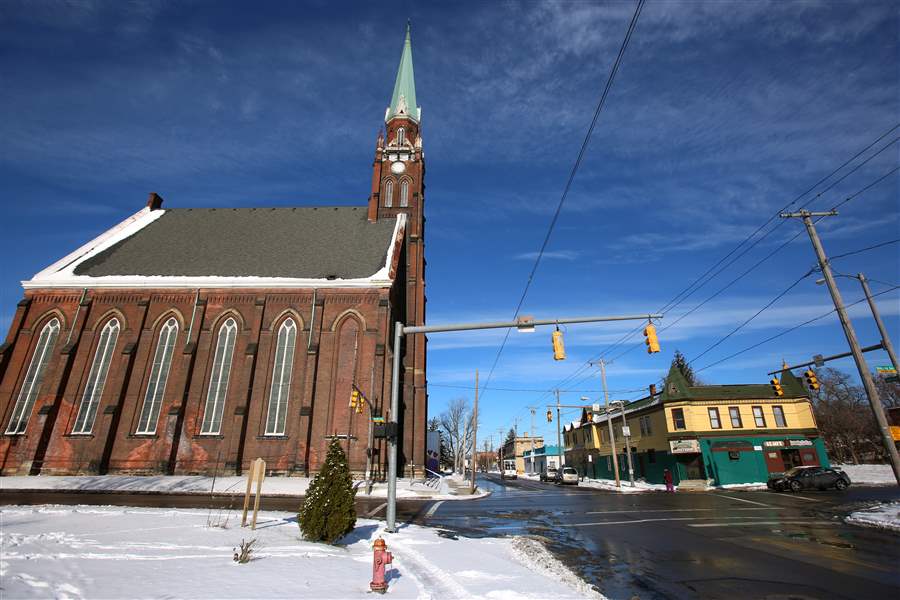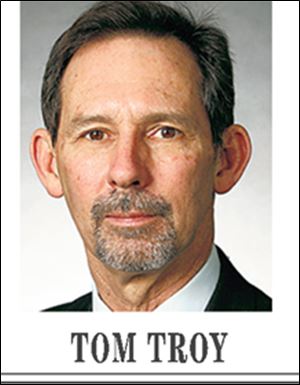
Kuschwantz’s last remnants slipping away
2/1/2018
St. Anthony Catholic Church in Toledo, which is scheduled to be demolished this year.
The Blade
Buy This Image

The planned demolition of St. Anthony’s Church at Nebraska and Junction avenues is a sad punctuation mark to an unfortunate event in American urban history: white flight.
St. Anthony’s is said to have one of the tallest church spires in the country.
It was built by rapidly growing Polish immigrant community in Toledo in the late 19th century.
When the church was finished in 1891, the Poles and Catholics of other ethnicities worshipping there must have assumed the church would last forever, just like the churches in Europe that continue to host religious assemblies centuries after the last stone was put in place.
As the home of a thriving congregation, St. Anthony’s barely lasted a century.
The book Toledo’s Polonia says the population went into a “steep decline” in the 1970s and 1980s. The parish closed for good in 2005.
That decline was well under way in the late 1960s, and middle-class Polish descendant families were fleeing to the suburbs.
Kuschwantz, as it was once known, bristled with Polish immigrant energy and enterprise, with bars on the corners, flower shops, auto mechanic shops, groceries, and churches.
Baseball teams by the dozens operated in the summer. The players joined the 14th Ward Old-Timers Club on Junction Avenue to celebrate their victories and drown the sorrow of defeat.
The Polish have moved on, dispersed into the general population of Sylvania and South and West Toledo and elsewhere. The 14th Ward Old-Timers are still a club, but they moved long ago from Junction to Airport Highway.
Two weeks ago I attended a funeral at St. Hyacinth’s Church that brought back some of the flavor of that period.
Friends and family of Dorothy Pozniak, who was 96 when she died, were taken back into her own youth and the youth of her three sons and one daughter by the eulogy of her son, Randy.
He told how his mother would go to the corner bar to buy her father a bucket of beer for a nickel, and how sometimes she had to play interference at home on behalf of her brother Chet who had got in trouble with the nuns at St. Anthony’s.
“Dottie” made spark plugs at Champion Spark Plugs for World War II aircraft. When her husband, Harry Pozniak, died in a work-related accident, she learned how to drive at the age of 51.
In Randy Pozniak’s telling, one of the worst things he did as a child was inform his mother an hour before the May procession, in which he was to be an altar boy, that his cassock needed ironing. What a scandal!
It’s normal for neighborhoods to change in ethnic composition. Irish and Germans lived in Kuschwantz before the Poles took over.
Toledo lost out when middle-class Polish families, especially with young men returning from World War II, looked outside the community for bigger, more modern homes, leaving behind closed grocery stores, churches, clubs, and corner taverns in their wake. To what extent was the influx of African-American families into the old Polish society a factor? One has to assume it played a part.
It is a totally different community today, under the name Kwanzaa.
St. Anthony’s was closed in 2005. Now the Diocese of Toledo says it will be demolished.
Remnants of St. Anthony’s, in the form of some of its statues, can be seen at St. Hyacinth on Parkside Boulevard, which keeps up the struggle to remake the community it lives in long after much of its founding ethnic base has left.
It’s too late to revive Kuschwantz. It’s not too late for all of Toledo’s neighborhoods to reverse the outflow to what they might think are greener pastures in the suburbs and breathe new life into old community landmarks.
Contact Tom Troy at tomtroy@theblade.com, 419-724-6058, or on Twitter @TomFTroy.